The custom t-shirt printing market is set to grow by 11% each year until 2030. This is a great chance for new entrepreneurs. Starting a t-shirt business can be done with little money, even from home. The cost can be as low as $26 or as high as $20,000, depending on your goals.
If you want to start a clothing line, a custom apparel business, or just try entrepreneurship, this guide is for you. We’ll cover the essential steps to start a successful t-shirt business. You’ll learn about choosing a niche, finding materials, designing cool graphics, and setting up an online store.
The t-shirt industry is competitive, but it’s also full of opportunities for creativity and profit. By understanding the market, knowing your audience, and using the right tools, you can find success in your t-shirt business.
Key Takeaways
- The custom t-shirt printing market is expected to grow by 11% per year through 2030, creating opportunities for entrepreneurs.
- Starting a t-shirt business can be done with minimal overhead, potentially from home, with costs ranging from $26 to $20,000.
- Choosing a niche, sourcing materials, creating designs, and setting up an online store are key steps in launching a t-shirt business.
- The t-shirt industry is highly competitive, but offers room for creativity and profit with the right strategies.
- Tools like Google Keyword Planner and Ahrefs can help assess consumer interest and identify sub-niches within the t-shirt market.
Understanding the T-shirt Business Market Potential
The t-shirt business market is a big chance for entrepreneurs. It’s growing fast because people want custom clothes and easy online shopping. This makes the t-shirt industry exciting and full of new trends.
Current Market Growth and Trends
The global t-shirt market is set to hit over $80 billion by 2025. This growth comes from personalized clothes, social media, and online shopping. People want unique t-shirts, which is great for t-shirt companies and apparel entrepreneurship.
Revenue Opportunities in Custom Apparel
There’s a big demand for print on demand shirts. Customers want t-shirts that show off their style. T-shirt businesses can use different printing methods to offer many customization options.
Industry Competition Analysis
The t-shirt business is competitive, but new entrepreneurs can still succeed. By focusing on specific niches, t-shirt companies can stand out. Tools like Google Trends help find what customers want, guiding business decisions.
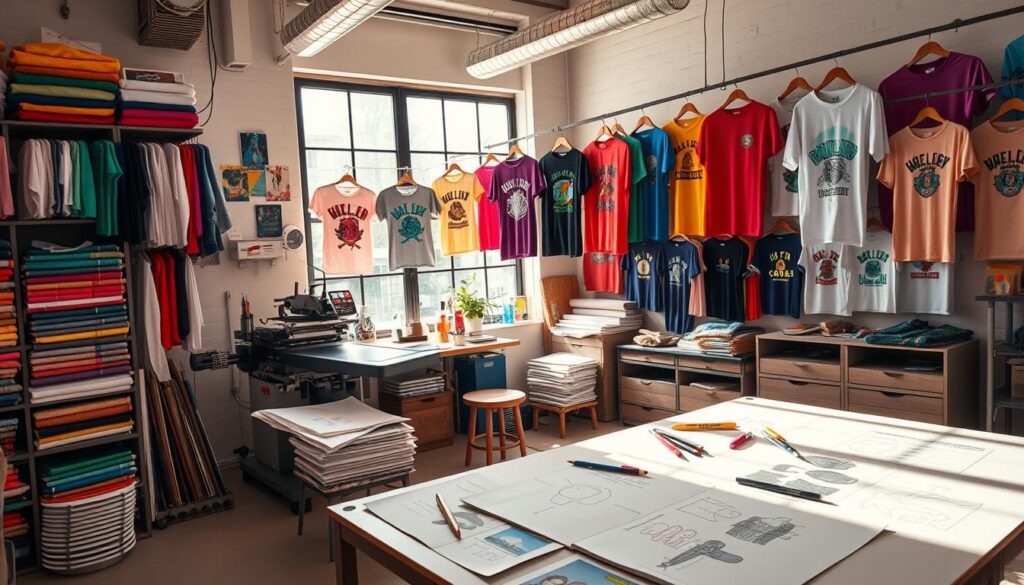
“The t-shirt industry is more exciting than ever, full of creative and entrepreneurial chances. By understanding the market and what customers want, new t-shirt business owners can thrive in this dynamic field.”
Identifying Your Target Audience and Niche
To succeed in the custom apparel business, you need to know your audience well and find a profitable niche. This strategy can make your t-shirt business thrive or struggle.
Start by doing market research with tools like Facebook IQ Audience Insights and Google Keyword Planner. They give insights into audience size, engagement, and search volume for different niches.
Think about focusing on specific sub-niches to stand out. Instead of just “funny t-shirts,” target “t-shirts with doctor slogans” or “funny t-shirts for dog owners.” This makes your products unique and attracts loyal customers.
| Niche Opportunity | Potential Size | Engagement Level | Search Volume |
|---|---|---|---|
| T-shirts with slogans about doctors | Medium | High | Medium |
| Funny t-shirts for dog owners | Large | Very High | High |
| Vintage-inspired band t-shirts | Medium | High | Medium |
Research shows that 85% of successful businesses have found a profitable niche. Also, 9 out of 10 customers prefer niche-specific t-shirt businesses. By focusing on a specific audience, your custom apparel business can shine in the industry.
Choosing a niche helps you tailor your marketing and designs. It also builds stronger customer relationships. Remember, 80% of niche market sales come from passionate consumers, and 3 out of 4 designs sell better with a simple, niche-relevant design.
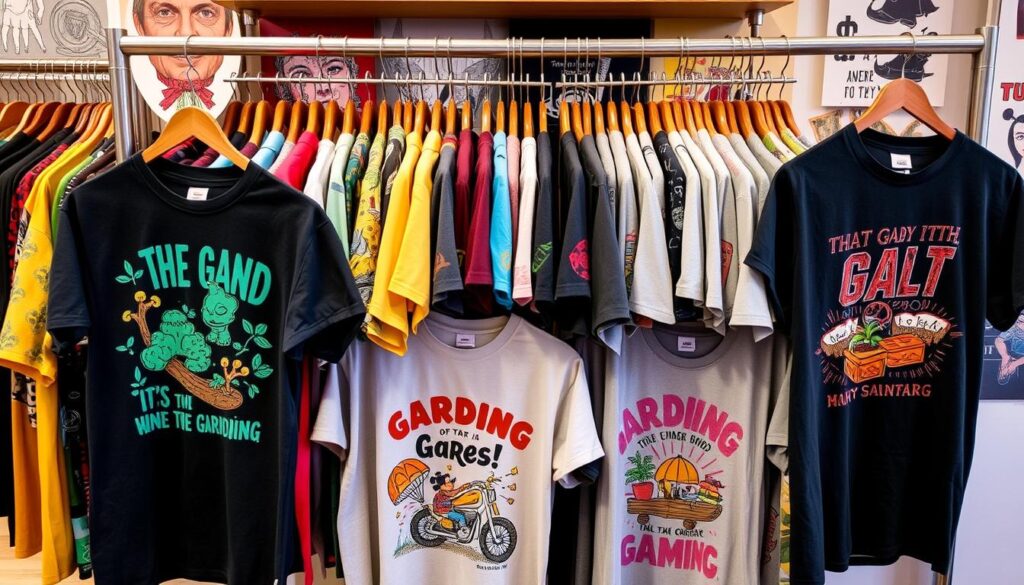
Finding a profitable niche gives you a big advantage in the custom apparel business and t-shirt design and printing world. This strategy will help your t-shirt business succeed in the long run.
Essential Equipment and Supplies Needed
To start a t-shirt business, you need the right tools and materials. You have several printing options like inkjet, laser, sublimation, and solvent printers. Inkjet and laser printers are cheaper and good for custom shirts.
Printing Equipment Options
There are three main ways to print on t-shirts: screen printing, heat transfer, and direct-to-garment (DTG) printing. Each method has its own benefits and drawbacks. Screen printing gives bright colors but costs more. Heat transfer is cheaper but the quality might not be as good.
Material and Supply Sources
For materials and supplies, join groups like the Specialty Graphic Imaging Association (SGIA) or the Promotional Products Association International (PPAI). These groups help you find suppliers and learn about the industry.
Storage and Workspace Requirements
The space you need depends on how you plan to print and manage your inventory. Screen printing needs a big space for equipment and materials. Heat transfer and DTG printing require less space because their equipment is smaller. A well-organized workspace is key for quality and efficiency.
| Printing Method | Pros | Cons |
|---|---|---|
| Screen Printing |
|
|
| Heat Transfer |
|
|
| Direct-to-Garment (DTG) |
|
|
To start a t-shirt business, think about the equipment, materials, and space you need. Knowing the pros and cons of each printing method helps you make the best choices for your business.
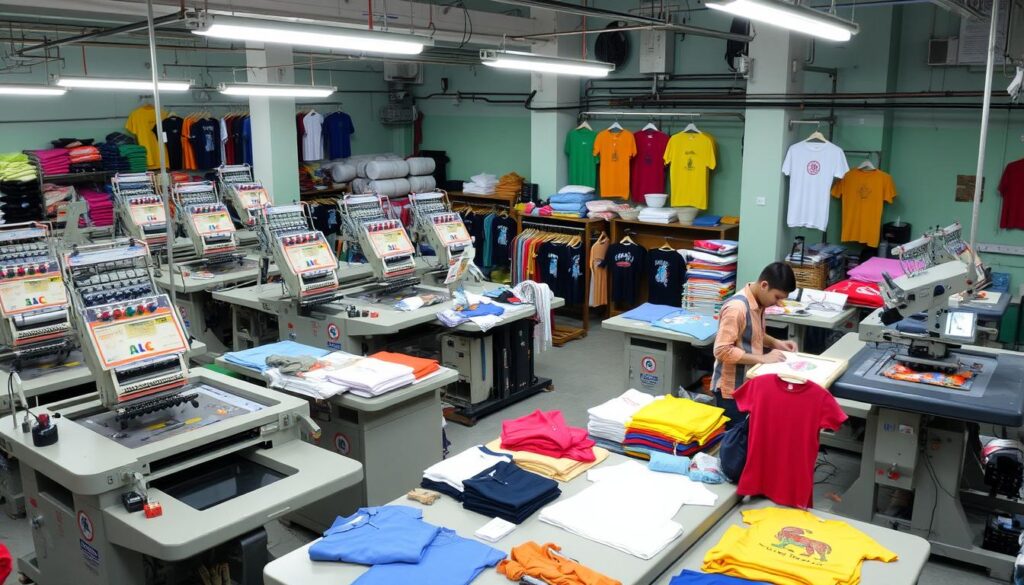
T-shirt Design and Production Methods
Starting a custom apparel business means picking the right t-shirt design and printing methods. These choices depend on your audience, order size, and budget. Each method, from screen printing to direct-to-garment (DTG) technology, has its own benefits and challenges.
For big orders with simple designs, screen printing is a smart choice. It’s affordable and produces great results. But, it’s not the best for complex, full-color designs.
Heat transfer printing works well for small batches and detailed designs. Yet, the quality and feel might not be as good as screen-printed shirts.
DTG printing uses digital tech to make high-quality, full-color designs on demand. It’s pricier for big orders but perfect for unique designs aimed at specific groups.
When picking a method, think about design complexity, order size, your audience, and your business goals. This ensures you choose the best fit for your t-shirt design and printing needs.
“The success of a t-shirt business lies in finding the perfect balance between creative expression and cost-effective production.”
The t-shirt design and printing method you choose is key to your custom apparel business‘s success. Knowing the strengths and weaknesses of each method helps you make a smart choice. This choice will help your business grow and thrive in the long run.
How to Start a Tshirt Business: Step-by-Step Process
Starting a t-shirt business needs a careful plan. You must know your audience, set up legal stuff, and manage operations. Each step is key to a successful clothing line startup. Let’s look at the important parts of this guide.
Business Planning Essentials
First, figure out your niche and who you’re selling to. Look at market trends and find what’s missing. Then, write a detailed business plan. It should cover your goals, money plans, and how you’ll market.
Legal Requirements and Registration
Make sure your t-shirt business follows the law. Register it, get any needed permits, and pick a legal form like a sole owner or LLC.
Setting Up Operations
Get the right tools and materials for making t-shirts. You might use a print-on-demand service or do it yourself. Plan how you’ll make and send out orders. Think about managing stock, shipping, and customer service for a smooth experience.
- Choose a niche and target audience
- Develop a comprehensive business plan
- Register your business and obtain necessary licenses
- Select printing methods and suppliers
- Set up your online store and payment processing
- Implement inventory management and order fulfillment
- Create a marketing strategy to attract and retain customers
By taking these steps, you’re on your way to a successful t-shirt business. You’ll get a piece of the growing custom apparel market.
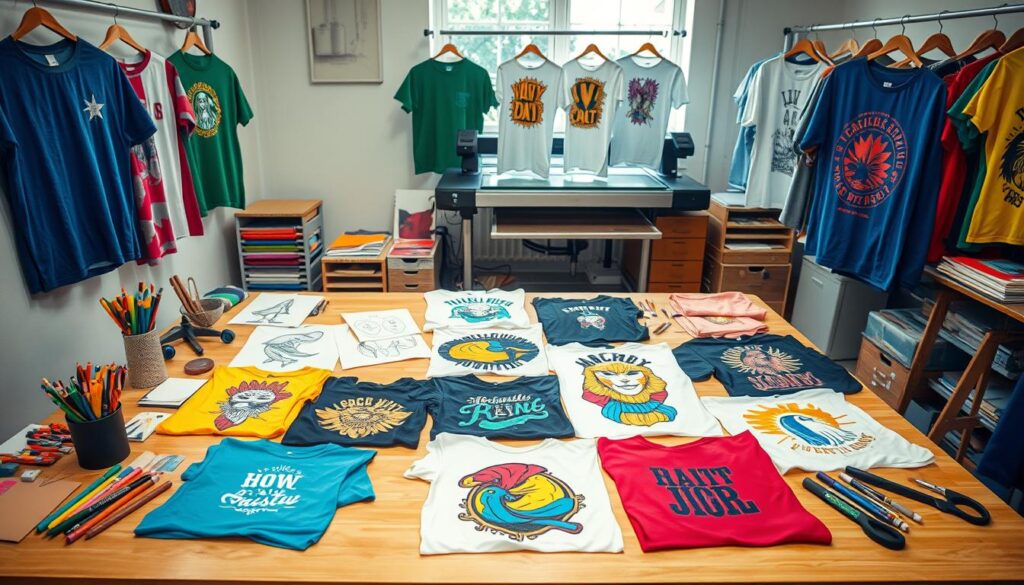
Choosing the Right Printing Technique
Starting a t-shirt business means picking the right printing method. This choice is key to making high-quality shirts and reaching your goals. There are many printing ways, each with its own good and bad points.
Screen printing is a common method for big orders of simple designs. It can save money, with costs from $1,500 to $10,000. But, it’s not great for complex or multi-color designs.
Direct-to-Garment (DTG) printing is perfect for small orders and detailed designs. It costs more to start up, from $15,000 to $20,000. Yet, DTG is easy to use and flexible, ideal for those who want to keep control and make more money.
Heat transfer printing is a budget-friendly option. It costs between $500 to $1,000 to start. It’s simple to set up and needs little space. But, it’s not ideal for growing your business beyond one person.
When picking a printing method, think about your design needs, order size, and business goals. Knowing the strengths and weaknesses of each method helps you choose the best one. This choice is crucial for your t-shirt business to grow and succeed.
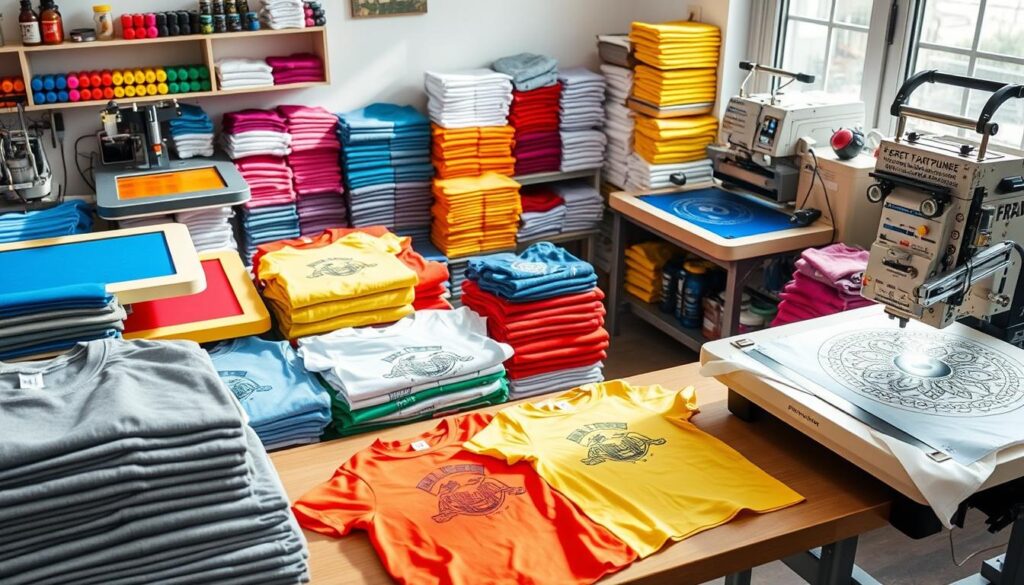
“Matching your business goals with the right t-shirt printing method is crucial to success and scalability in the industry.”
Sourcing Quality Materials and Suppliers
For a t-shirt business, getting top-notch materials is key. It makes customers happy and helps your brand grow. Think about the fabric type, weight, and quality when picking materials. Working with trusted suppliers can also save you money and keep your materials coming.
Fabric Selection Guidelines
Picking the right fabric is crucial for comfy, durable, and good-looking t-shirts. Some key factors to consider include:
- Fabric type: Cotton, polyester, blends, and other materials all have unique properties that can impact the look, feel, and performance of your t-shirts.
- Fabric weight: Heavier fabrics may be more suitable for certain designs or seasons, while lighter fabrics can provide a more comfortable and breathable wear.
- Fabric quality: Investing in high-quality fabrics can result in t-shirts with a better fit, softer feel, and longer-lasting durability.
Establishing Wholesale Vendor Relationships
Strong relationships with suppliers are vital for getting quality materials at good prices. When looking at vendors, think about:
- Reputation and reliability: Choose vendors known for quality products and great service.
- Pricing and minimum order quantities: Talk about prices and orders to help your business grow.
- Turnaround time and delivery: Make sure vendors can meet your deadlines and deliver on time.
Implementing Quality Control Measures
Keeping quality high is crucial for customer trust and a good brand image. Use strong quality control steps, like:
- Ordering and inspecting product samples: Check the fit, sizing, material, softness, and weight of samples to meet your standards.
- Establishing quality checks throughout the production process: Watch the quality at every step, from fabric to packaging, to catch and fix problems.
- Seeking customer feedback: Get feedback from customers to know what they think and how to improve.
By choosing quality materials, building strong vendor ties, and using quality control, your t-shirt business will meet and exceed customer expectations. This will help your brand succeed.
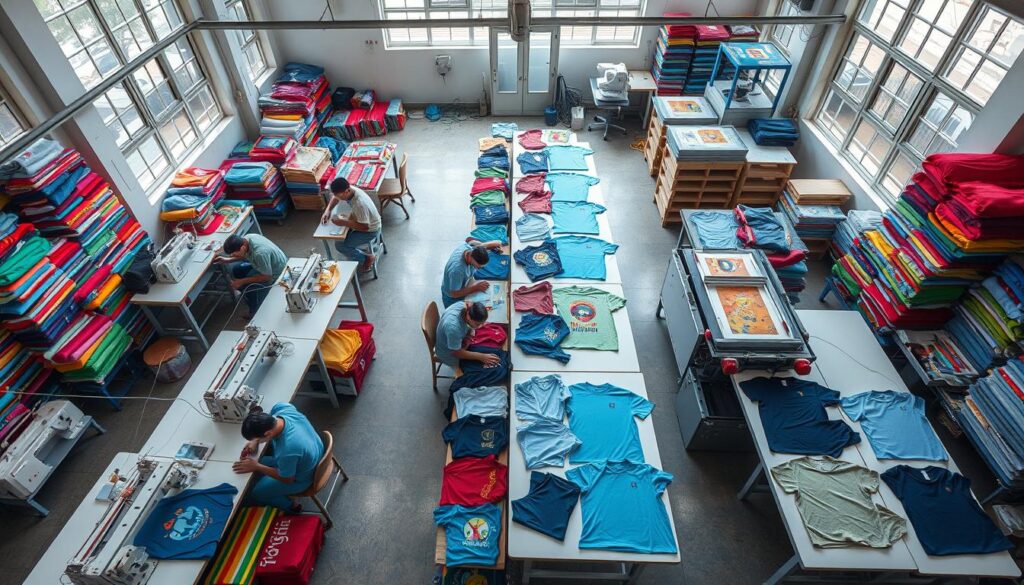
Creating a Strong Brand Identity
In the competitive clothing line startup and t-shirt company market, a strong brand identity is key. Your brand is the foundation of your business. It shapes how customers see and connect with your products. By having a unique voice, visual style, and consistent message, you can make a lasting impression.
Think about your logo design, color palette, and packaging when building your brand. These elements should show your brand’s personality and values. They should appeal to your target audience. Being consistent across all platforms, like your website and social media, builds recognition and loyalty.
Looking at successful t-shirt brands can inspire and help you stand out. Study how they’ve positioned themselves, their design choices, and the messages that connect with their customers. Use these insights to create a brand identity that makes your clothing line or t-shirt company unique.
| Brand Example | Brand Identity Approach | Impact on Brand Recognition |
|---|---|---|
| 316Tees | Emphasizes religion to outline its mission | Established a strong connection with a specific target audience |
| Green Shirts | Highlights its commitment to creating eco-friendly T-shirts, showcasing its use of sustainable materials | Differentiated itself in the market by aligning with the growing demand for sustainable fashion |
| Cool Cats | Created a brand character featured on all their products, enhancing brand recognition | Developed a distinctive and memorable brand identity that resonated with customers |
| Glennz | Used unique and out-of-the-ordinary images to make their brand stand out | Established a strong visual identity that captured the attention of their target audience |
Your brand identity is more than just visuals; it’s about the story you tell and the connection you make with customers. Using social media to share your brand’s story and engage with your audience can strengthen your brand presence and loyalty.
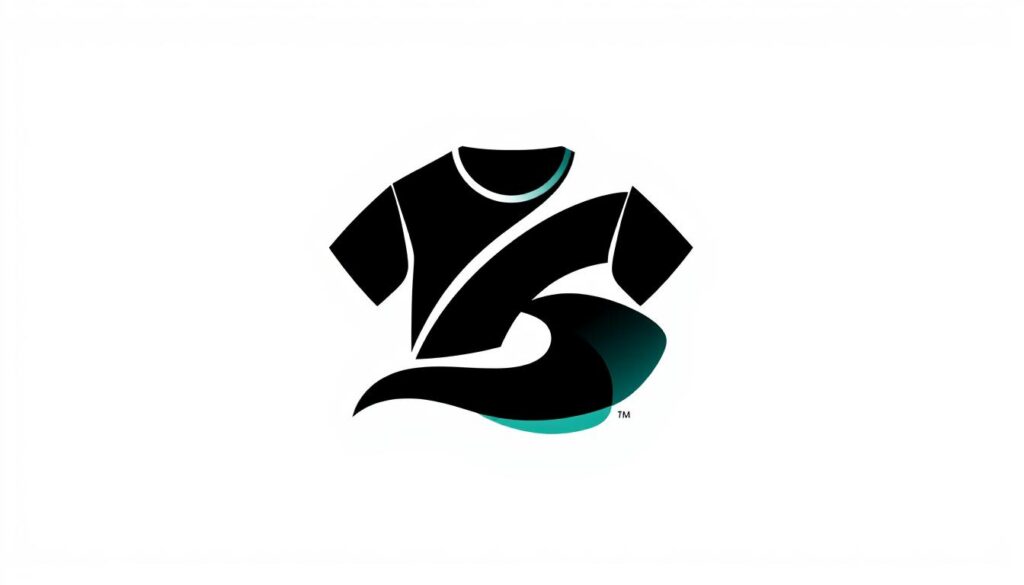
“A strong brand identity is the key to survival and growth in the clothing line startup and t-shirt company market. It’s what sets you apart and makes you memorable to your customers.”
Setting Up Your Online Store
In today’s world, having an online presence is key for any t-shirt business. An online store lets you show your designs to more people and make ordering easier. It’s a vital step, whether you’re starting or growing your business.
Choosing an E-commerce Platform
First, pick the right e-commerce platform. Shopify, WooCommerce, and Etsy are great choices. They’re easy to use, have lots of features, and work well with print-on-demand services. Think about how easy it is to use, how customizable it is, and if it works with your printing and shipping needs.
Designing a Visually Appealing Website
Invest in a professional website design. A good website makes shopping easy and looks great. It shows off your products well and builds trust with your customers. Make sure it works well on phones, is easy to use, and shows off your brand.
Implementing Secure Payment Processing
Secure payment options are crucial for trust and smooth transactions. Use payment gateways like PayPal, Stripe, or Square. This makes checkout easy and safe for your customers.
Choosing the right platform, designing a great website, and using secure payments are key. They help you reach more people, make ordering easier, and build your brand’s trust in the competitive t-shirt market.
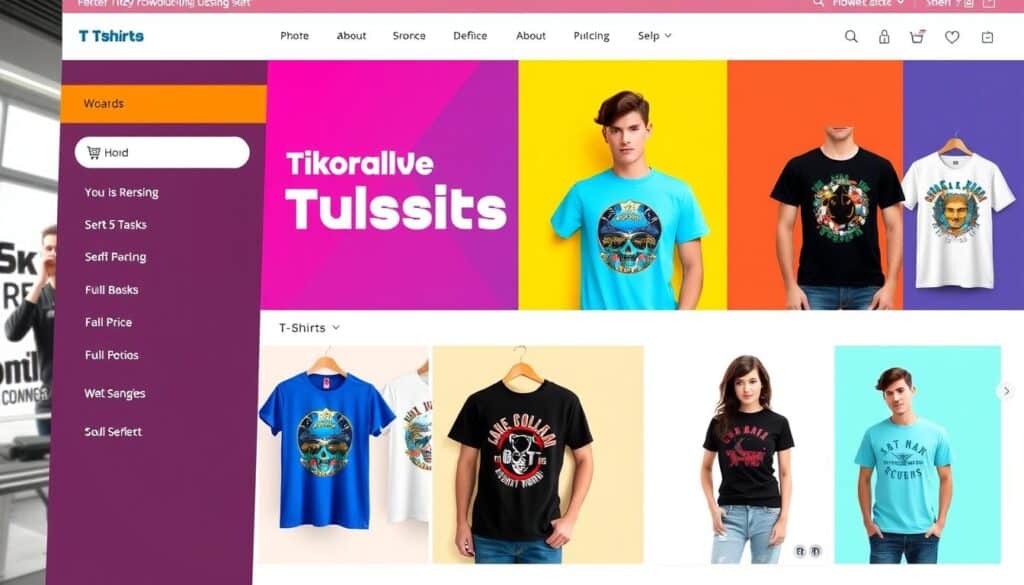
Pricing Strategies and Profit Margins
Starting a t-shirt company means you need to set prices right. You must think about production costs, what others charge, and how much people value your shirts.
One way to price is to double the cost of making the shirt. But, you should also check what your customers are willing to pay. Try different prices to see what works best for you.
Use tricks like pricing at odd numbers to make your shirts seem more valuable. Showing the original price next to the sale price can also make your deal look better.
Offering different prices for different quantities can help too. Selling more than one shirt at a time can make customers feel like they’re getting a good deal.
Experts say you should aim for a 30 to 40% profit margin. To find your price, use this formula: Retail Price = [(cost to produce) ÷ (100-profit %)] x 100.
Getting your pricing right is all about research, understanding costs, and trying new things. Listen to your customers and keep up with trends. This way, you can make money and keep your customers happy.
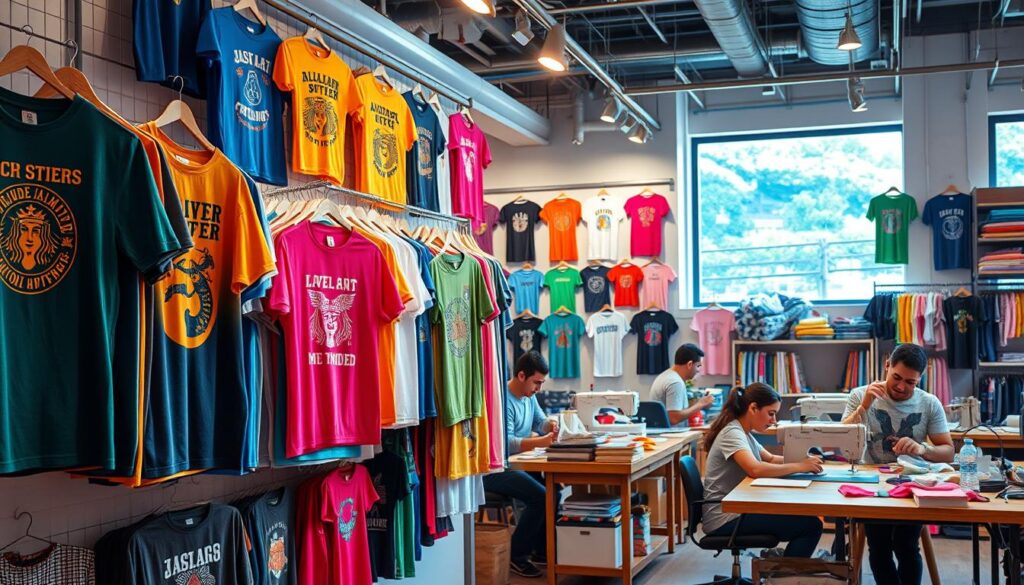
“Pricing is not just a number, it’s a strategy. The right pricing can make all the difference in the success of your t-shirt business.”
Marketing and Promotion Techniques
Starting a custom apparel business online? You need to market and promote well to attract customers. Today, with 93% of Americans online, using different marketing strategies is key.
Social media is a powerful tool. Sites like Instagram, Facebook, and Twitter are great for showing off your t-shirts. Post high-quality images and interact with your followers to build a strong brand.
SEO is also important for your online t-shirt store. Make your website easy to find by optimizing it and using the right keywords. This helps more people see your custom apparel business.
Working with influencers is another smart move. Partner with people who have lots of followers and share your values. This can help you reach new customers and grow your brand.
Email marketing is also valuable. Build a big list of subscribers and send them interesting emails. This keeps your brand in their minds and encourages them to buy more.
Don’t forget about word-of-mouth marketing. Happy customers can help spread the word about your t-shirts. This is a cost-effective way to get more customers and build loyalty.
Use a mix of social media, SEO, influencer partnerships, email marketing, and word-of-mouth to succeed. This way, you can reach and engage your audience, helping your online t-shirt store and custom apparel business thrive.
“Effective marketing is not about throwing money at the problem. It’s about being strategic, understanding your target audience, and utilizing the right channels to reach them.” – John Doe, Marketing Strategist
Managing Inventory and Orders
Keeping your t-shirt business running smoothly is key. A good stock management system helps you track what you have. It also lets you know when to order more. This way, you can always have what customers want.
Stock Management Systems
Use inventory management software or spreadsheets to manage your stock. This helps you:
- Keep an eye on stock levels and get alerts when it’s time to order more
- Plan ahead to avoid running out of products
- Organize different sizes and colors of t-shirts
- Check your stock regularly to catch any mistakes
Order Fulfillment Process
Make sure orders are filled quickly and correctly. Consider using print-on-demand services to save money and offer lots of designs. Have a clear plan for handling orders, packaging, and shipping.
Shipping and Handling
Create a detailed shipping policy. It should cover delivery times, returns, and any extra costs. Look for the best shipping deals and negotiate rates to save money.
With good inventory management, efficient order handling, and smart shipping, your t-shirt business will run smoothly. Customers will be happy with their experience.
Scaling Your T-shirt Business
As your clothing line startup or t-shirt company grows, it’s time to scale up. You should expand your product line, reach new markets, and improve your workflow. These steps will help take your business to the next level.
To grow your t-shirt business, think about offering more products. You could add new designs, try different types of garments, or partner with other brands. This way, you can attract more customers and meet their changing tastes.
Looking into wholesale deals and partnerships with stores can also boost your business. By selling more through different channels, you can reach more people and make more sales. Using automation and efficient order handling helps you keep up with demand without losing quality or customer service.
It’s key to keep an eye on your sales and what customers say. This helps you find new ways to grow and improve. Use this info to tweak your marketing, adjust prices, and guide your t-shirt company forward.
Scaling your t-shirt business takes time, planning, and being open to change. By using these strategies, you can turn your clothing line startup into a successful, lasting business.
Conclusion
Starting a t-shirt business is a great way to enter the apparel world. It’s affordable and has lots of room to grow. To do well, you need to be creative, smart about marketing, and efficient.
Choosing a specific area to focus on is key. Make sure your products are top-notch and your brand stands out. This way, you can build a successful t-shirt business that people love.
The t-shirt market is always changing. It’s important to keep up with trends and what customers want. Use tools like Google Trends and social media to understand what people like.
This knowledge helps you make smart choices and stay ahead. It’s all about offering unique designs, running smoothly, and promoting your brand well. With hard work, creativity, and knowing your market, you can make your t-shirt business a big success.
